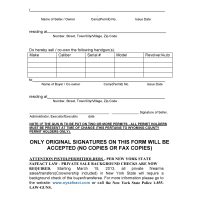

Once that reasonable amount of time has expired, the business is deemed to have actual or constructive knowledge of the dangerous condition, which imposes liability. Botsford, 109 A.D.3d 1182) Use of this doctrine requires defendant to establish as a matter of law that there was a storm in progress at the time of the accident ( see Alvarado v Wegmans Food Mkts., Inc., 134 AD3d 1440 (2015)). The doctrine applies to severe or inclement winter weather conditions. Dolgencorp also sought summary judgment, pleading the ongoing storm doctrine, which provides that a business should have a reasonable amount of time after the cessation of a storm to commence snow and ice removal before liability is imposed. On appeal, the Appellate Division, Fourth Department held that the Supreme Court’s granting of summary judgment on behalf of Fitzgerald and Forever Green was clearly proper, but the that in their own moving papers, Dolgencorp, the land owner, raised an issue of fact precluding summary judgment. Therefore, Kimberly Fitzgerald individually and as Forever Green merely had to show there was no contractual duty to plaintiff, clearly evidenced through submission of a copy of the contract, and the Supreme Court granted summary judgment. However, plaintiff failed to allege any of aforementioned exceptions, either in the complaint or in the bill of particulars, a device used to “amplify” the allegations in the complaint. In this case, plaintiff slipped and fell in the parking lot of a Dollar General store, and sued Dolgencorp of New York, Inc., who leased the premises, and Kimberly Fitzgerald, individually and doing business as “Forever Green Property Maintenance.” Forever Green was contractually responsible for snow removal of the premises in question. The recent case from the Fourth Department, Govenettio v. So what happens when the plaintiff fails to allege any of the exceptions? Can the contractor escape liability by merely demonstrating that plaintiff was not party to the contract under which the contractor was obligated to render services? The Court looked at this issue in the recent case of Govenettio v. Alleging an exception shifts the burden to the independent contractor to affirmatively negate the application thereof. Therefore, a plaintiff seeking to hold an independent contractor liable in tort must either be in privity of contract with the contractor, or allege facts that would establish the applicability of any of the three aforementioned exceptions. (3) where the contracting party has entirely displaced the other party's duty to maintain the premises safely, often by controlling a substantial portion of the premises or activities therein. (2) where the plaintiff detrimentally relies on the continued performance of the contracting party's duties, and

(1) where the contracting party, in failing to exercise reasonable care in the performance of his duties, “launche a force or instrument of harm” , 98 N.Y.2d 136 (2002) laid out the three exceptions to this general rule, which would give rise to such third party independent contractor liability: It is only when a contractor enters into a contract to render services and assumes greater duties than average, that it may be said to have assumed a duty of care and thus be potentially liable in tort to an injured plaintiff.

The general rule is that a contractor owes a duty of care only to those who are in privity of contract - that is, who are direct parties to the contract. Such a contractual obligation between the landowner and the contractor, on its own, will generally not give rise to tort liability in favor a third party, such as an injured plaintiff. However, an obligation like maintenance can be contracted out and assigned to a third party. Generally, an owner of property open to the public owes a duty of care to potential plaintiffs from dangerous conditions which the owner knew or should have known about with a reasonable inspection of the premises, that is, an owner with actual or constructive knowledge of that condition. Who owes you a duty of care? Is it X? Is Y? Is it both? Determining who has a duty of care, however, is not always straight forward, especially where multiple parties are at play.Įxample: you slip and fall on ice in a shopping mall parking lot, owned by person X, who has contracted with person Y to be responsible for snow and ice removal. To be liable for negligence in a personal injury action, it must be established that the defendant owed a duty of care to the plaintiff, that the duty was breached, and that said breach caused the plaintiff’s injuries.


 0 kommentar(er)
0 kommentar(er)
